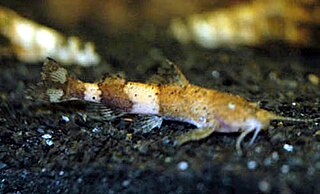
Sisoridae is a family of catfishes. These Asian catfishes live in fast-moving waters and often have adaptations that allow them to adhere to objects in their habitats. The family includes about 235 species.

Pseudolaguvia is a genus of South Asian river catfishes. These species inhabit hill streams and large rivers. P. tenebricosa is found in fast running, clear water; the river has a sandy bottom and numerous rocks and boulders and aquatic vegetation is absent. P. inornata is from clear, shallow, moderately flowing streams with a predominantly sandy bottom. P. muricata is found in clear, shallow, slow-flowing streams with a mixed substrate of sand and detritus; these fish are found amongst detritus in areas with current. P. ferula is also found in swift flowing waters with a mixed rocky/sandy bottom.
Oreoglanis macronemus is a species of sisorid catfish. It is known only from four preserved specimens collected from the Xiangkhoang Plateau, northern Laos, by an expedition led by Jean Théodore Delacour in the mid-1920s and misidentified as Euchiloglanis sp. These specimens are in the Natural History Museum, London.

Glyptothorax is a genus of catfishes order Siluriformes of the family Sisoridae. It is the most species-rich and widely distributed genus in the family with new species being discovered on a regular basis. These species are distributed in the Black Sea basin, northern Turkey, south and east to the Yangtze River drainage in China and south throughout Indo-China to Java, Indonesia. They are found in Asia Minor and southwards to Southeast Asia. The genus is very diverse in the Indian subcontinent. Southeast Asian species tend to have restricted distributions.

Pseudecheneis is a genus of sisorid catfishes native to Asia.

Amblyceps is a genus of fish in the family Amblycipitidae. The genera Amblyceps and Liobagrus are sister group pair that is, in turn, sister to Xiurenbagrus. These species are easily distinguished by the presence of pinnate processes along with the median caudal-fin rays, a prominent cup-like skin flap above the base of the pectoral spine, and the adipose fin largely separate from the caudal fin. In most species the caudal fin is deeply forked; A. apangi and A. murraystuarti differ in having their caudal fin truncate. Amblyceps species may reach about 100 millimetres (3.94 in) SL.
Exostoma is a genus of sisorid catfishes native to Asia. These species are distributed in the Brahmaputra drainage of north-eastern India, and east and south to the Salween drainages in Burma. E. berdmorei is found in the Sittang and Salween drainages in Burma. E. labiatum is known from the Brahmaputra drainage in north-eastern India, but has also been recorded in the Salween drainage in Burma, the Ayeyarwady drainage in China, and the Brahmaputra drainage in Tibet and Burma. E. stuarti is from the Ayeyarwady River of Burma and India; however, it has not been collected since its original discovery. E. labiatum is found in mountain rapids.
Pareuchiloglanis is a genus of sisorid catfishes native to Asia. These species are rheophilic catfish chiefly found in the headwaters of major rivers in South and East Asia. They originate from the Brahmaputra drainage in India, east and south to the Yangtze drainage in China and the Annamese Cordillera drainages in southern Vietnam. Two species are known from the Mekong River: P. myzostoma and P. gracilicaudata. Four species are known from the drainage of China: P. abbreviatus, P. gracilicaudata, P. myzostoma and P. prolixdorsalis.
Exostoma peregrinator is a species of sisorid catfish in the family Sisoridae. It is found in Thailand.
Oreoglanis heteropogon is a species of catfish in the family Sisoridae found in the Salween River drainage in western Thailand which was discovered by Vidthayanon, Saenjundaeng and H.H. Ng in 2009.
Oreoglanis laciniosa is a species of catfish in the family Sisoridae found in the Mae Sa Nga drainage, a tributary of the Salween River in western Thailand which was discovered by Vidthayanon, Saenjundaeng and H.H. Ng in 2009.
Oreoglanis tenuicauda is a species of catfish in the family Sisoridae only known from the type locality in the upper reaches of the Nan River drainage, itself a tributary of the Chao Phraya River in northern Thailand which was discovered by Vidthayanon, Saenjundaeng and H.H. Ng in 2009.
Oreoglanis lepturus is a species of catfish in the family Sisoridae found in Laos.
Oreoglanis insignis is a species of catfish in the family Sisoridae found in the upper Irrawaddy and Salween river drainages in northern Myanmar and southwestern China.
Oreoglanis frenata is a species of catfish in the family Sisoridae found in Laos.
Oreoglanis hypsiura is a species of catfish in the family Sisoridae found in Mekong basin in Laos.
Oreoglanis delacouri is a species of catfish in the family Sisoridae found in Laos and China.

Oreoglanis hponkanensis is a species of catfish in the family Sisoridae found in Myanmar.
Oreoglanis macroptera is a species of catfish in the family Sisoridae found in Myanmar and China.
Oreoglanis majuscula is a species of catfish in the family Sisoridae, found in the Kameng River in Arunachal Pradesh state, Brahmaputra drainage, India.






